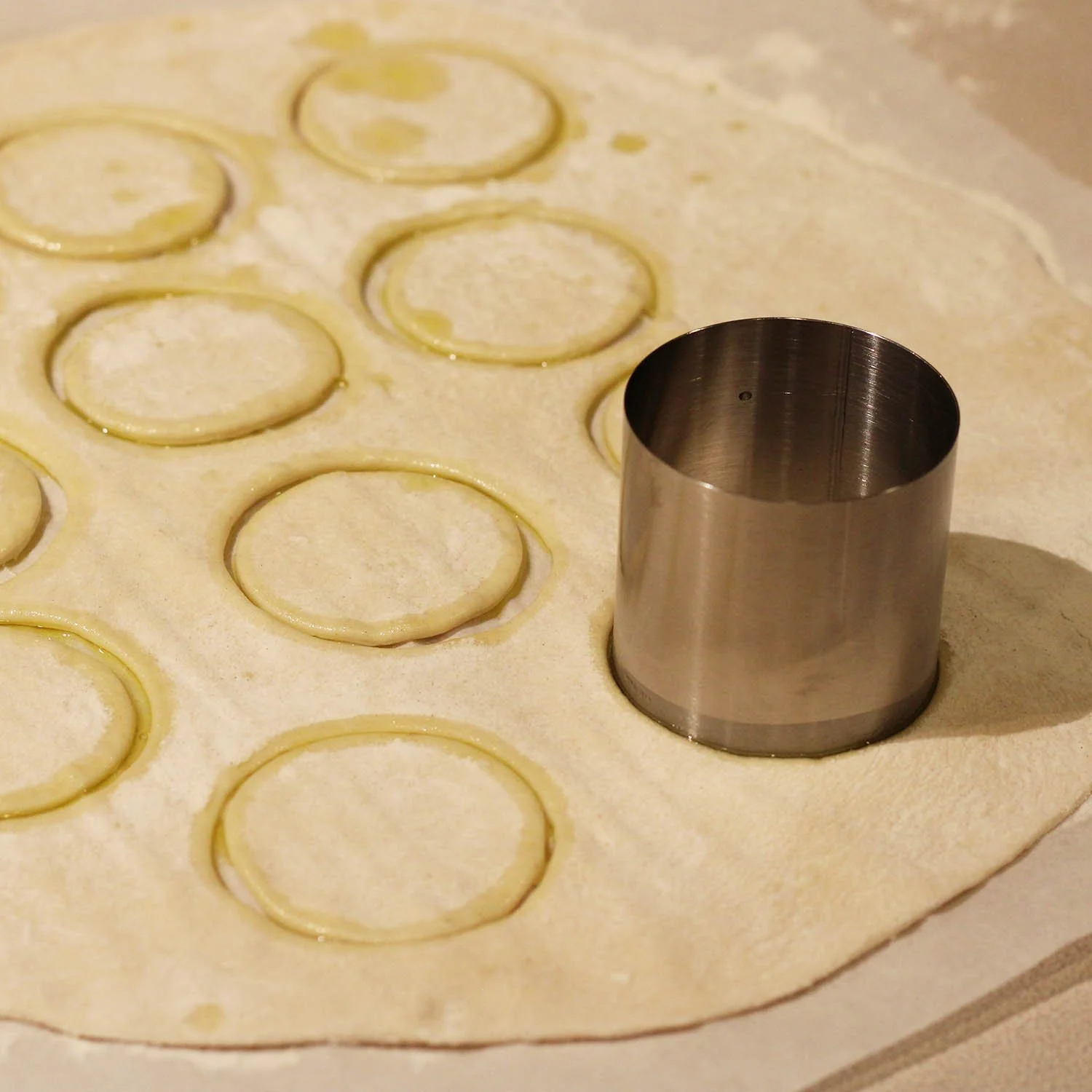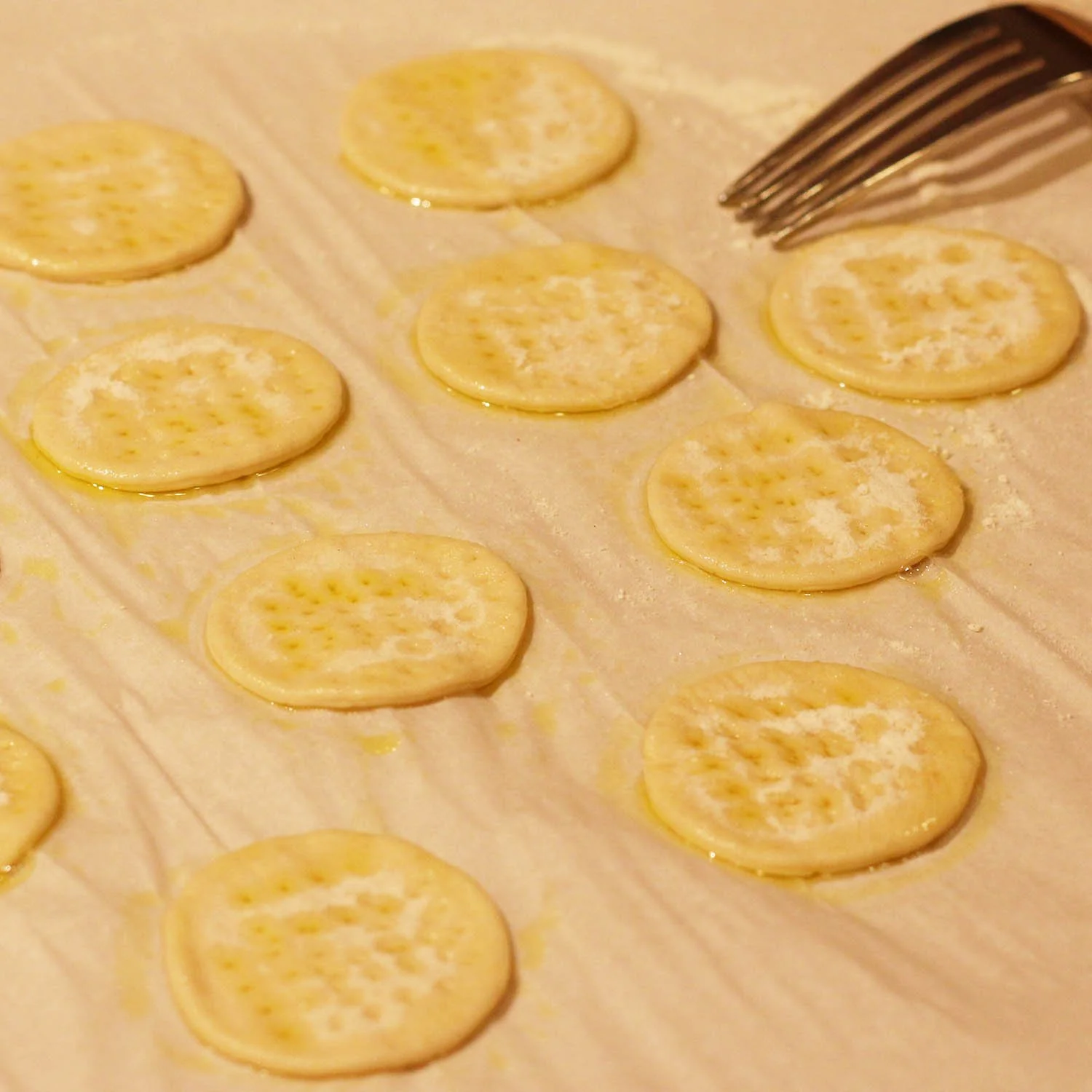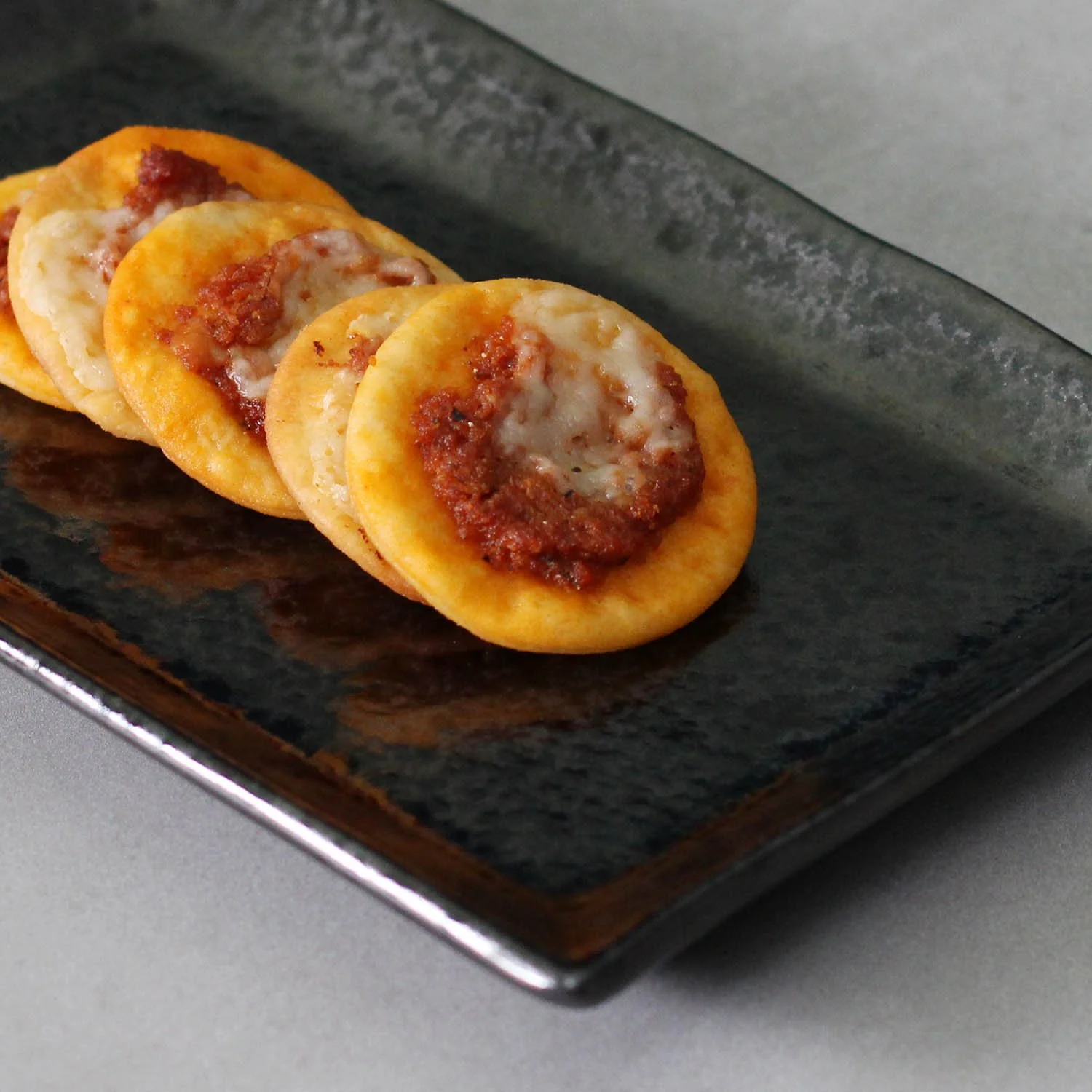Savory Canapés Recipes| Gourmet Baked Hors d’oeuvres
Savory Canapés
Savory Canapés make excellent gourmet Hors d'oeuvres for entertaining guests, especially during the holidays. Canapés are Hors d'oeuvres built upon a base, typically a small piece of bread cut into a square, circle, or other shape. The base is then topped with various combinations of flavorful items. For the baked canapés in this recipe, the toppings are placed on a yeasted dough base and baked. The base follows the basics of a cold-fermented pizza dough. This type of dough results in mini, thin, pizza-like crusts that are very savory. Canapés are intended to be small and eaten with your fingers.
For the correct pronunciation of the French word canapés, this short video is helpful. The translation of Canapés is "couch," think of the toppings as resting upon a couch of bread, or a thin pizza-like crust for this recipe. When the Canapés are made in this manner, they are very sturdy with the toppings bonding with the thin crust. They can be presented leaning against each other on a serving tray with no worry of the toppings falling off. They make for exceptionally clean gourmet Hors d'oeuvres.
Canapé Variations
I list several topping recipes for making savory Canapés. The principle behind this recipe is that you use a standard base made from one large batch of dough and add assorted toppings made in small batches. The different toppings vary in both flavor and appearance, giving a variety for guests to choose from and enjoy. All these varieties have the same cooking time and temperature.
The Canapé Base
It starts with a batch of cold-fermented yeasted dough, made one to a few days ahead of when you plan to prepare the canapés. The dough is divided into small balls, then rolled into thin sheets. The canapé bases are cut out with a two-inch pastry ring dipped in olive oil. This creates a clean cut, and the scrap dough pulls away easily without distorting the dough discs. The discs are then docked with a fork dipped in olive oil. This keeps the dough from bubbling while baking and maintains a thin crust for the savory toppings. Docking with a fork dipped in olive oil helps maintain open holes for the toppings to absorb into. Overall, the olive oil helps the dough brown at the edges as it bakes. It is the same for all dough bases, regardless of the toppings.
Cutting the dough discs for baked Canapés
Docked dough discs for baked Canapés
The Canapé Toppings
This is where the canapés deviate from the standard base yeasted dough disc with topping variations in both flavor and appearance. The idea is to create an array of canapés that vary in using different savory ingredients. To achieve a savory flavor profile, the canapé toppings use an umami ingredient, such as aged cheeses, tomato paste, or cured meats, or a combination of umami ingredients. You can read more about various umami ingredients on my page for Umami Sauce For Savory Foods.
Baked Canapés Dough Recipe
The dough is intended to be conducive to cold fermentation and to roll out easily. The dough contains champagne vinegar, which helps impart the characteristics needed for rolling and creates a slightly acidic environment conducive to good yeast growth. The mild champagne vinegar also adds to the overall flavor profile. This is a cold fermentation dough for one or two nights in the refrigerator and a maximum of three nights. The recipe yields about an 820-gram ball of dough, divided into 5 pieces, each weighing 164 grams, for 5 rolled-out dough rounds about 10 to 12 inches in diameter. You then use a 2-inch pastry ring to cut the dough into discs, yielding about 16. The total batch of dough yields up to 80 canapés.
Dough Ingredients
4-1/3 cup (520 g) all-purpose flour, divided
1-1/4 cups (300 g) water
1-1/2 tsp fine-grain sea salt
1 tsp champagne vinegar
1 tbsp Extra Virgin Olive Oil
1/2 tsp granular white sugar
1 tsp dry yeast, or 1 tbsp fresh yeast, for one or two nights of cold fermentation
Dough instructions
Warm the water to 110°F, add the 1/2 tsp sugar and 1/3 cup (40 g) of the flour, and the yeast. Stir the ingredients and allow them to bloom for 15 minutes. The mixture should be frothy.
Add the frothy yeast mixture to your stand mixer bowl. Add the remaining 4 cups (480 g) of flour to the liquid mixture.
Run the mixer on medium for 3 minutes.
Add the vinegar mixed with the olive oil and the salt.
Run the mixer medium-high for 3 more minutes.
Remove the dough from the mixer bowl, form it into a ball, and place it into a container lightly coated with olive oil. Seal the container with a lid and refrigerate for one to three days.
Forming and Cutting The Dough Disc For Canapés
Remove the dough from the refrigerator and form it into 5 equal-sized balls. You can let the dough warm for an hour or two at room temperature before you roll it out into sheets. I typically wrap each dough ball in some clear cling wrap until I am ready to roll it out.
Roll a ball of the dough into a sheet about 1/8 inch thick and 10 to 12 inches round on lightly floured parchment.
Add 1/4 cup of olive oil to a small bowl.
Dip a 2-inch-diameter pastry ring into the bowl of olive oil, ensuring it reaches up the ring by 1/4 to 3/8 inch.
Press the pastry ring into the dough sheet to cut the discs.
Peel back the extra dough scrap from around the discs.
Dock each disc in two directions with a fork dipped in olive oil. As this is a yeasted dough, it will bubble and rise while baking if you don't thoroughly dock it.
Carefully transfer your parchment with the individual docked dough discs to a sheet pan, then add the toppings.
You repeat this five times for the five-ball batch of dough. You can vary the toppings as you wish, selecting from the topping recipes below.
Adding The Canapé Toppings
Typically, you only need about one rounded 1/8 tsp of toppings per canapé base. For cubed cheese that may be added on top of the topping, you typically only need about a 3/8-inch (1 cm) cube.
Baking The Canapés
Bake in a preheated oven at 425°F on the center rack for 10 minutes.
Remove the Canapés after baking and transfer to a cooling rack for 10 to 15 minutes.
Serving The Baked Canapés
The baked canapés are very versatile in how you serve them. The base is firm, more solid than a cracker with some chew. Biting into them does not produce crumbs like a cracker, so they are perfect as finger food, making them excellent hors d'oeuvres for formal entertaining. The toppings all adhere well to the base. To present them to your guests, you can lay them out individually, flat, in rows, or stack them against one another without worrying about the toppings falling off.
Savory Toppings Recipes
The following are different savory toppings for baked Canapés. I typically make several toppings a day before making the final Canapés. The toppings are refrigerated overnight in a sealed container. Each recipe yields about 6 to 10 oz (170 to 284 grams) of toppings.
Canapés Pepperoni Topping
This topping for the baked canapés uses pepperoni and other ingredients puréed into a thick paste using a food processor. It is best to make this topping the day before you make your baked canapés, storing it in the refrigerator overnight in a small, sealed container. Overnight refrigeration allows the mixture to stiffen, making it easier to handle when applying it to the canapé dough bases. The overnight refrigeration also allows the flavors to meld. The quantity of ingredients listed below yields about 6 ounces (170 grams). This topping mixture batch with about 3 grams per canapé can easily yield 60 canapés.
The canapés start with the yeasted dough base, followed by the pepperoni topping mixture, then topped with a small cube of Fontina cheese. As these are small canapés, measuring 2 inches (5 centimeters). The toppings are best applied in small amounts directly on the center of the dough base. Using 1/8 tsp of the paste topping and a 3/8-inch (1 cm) cube of cheese pressed into the paste is adequate.
Pepperoni Canapés with Fontina cheese
Ingredients for Pepperoni Canapés Toppings
2 tbsp tomato paste
1 tbsp Extra Virgin Olive Oil
2 tbsp water
2 tbsp red wine
1/4 tsp coarse-ground black pepper
1/4 tsp fine-grain sea salt
1/2 tsp granulated sugar
1/2 tsp Italian seasoning
1/4 tsp garlic powder
1.5 oz pepperoni, diced.
2 oz Shaved Parmesan cheese
Instructions For The Pepperoni Topping
In a small saucepan, brown the tomato paste in olive oil over medium heat for 2 minutes, then let the mixture cool for a few minutes.
Add the water and wine to the browned tomato paste, stirring to combine.
Add the dry seasoning ingredients, including sugar and salt, and stir well to combine.
Over low heat, sauté the mixture for 1 to 2 minutes. It will be a very thick paste; do not over-sauté. Only brief, gentle heating is needed to bloom the herbs and meld the flavors. Then let the mixture cool for about 5-10 minutes while you prepare the items for the food processor.
Slice the pepperoni into small pieces and set aside.
Using a vegetable peeler, shave 2 oz of Parmesan from a portion of a wedge. Cut the cheese into thin strips. The thin strips of cheese are easier to purée in the food processor.
Using a food processor with an S-shaped metal blade, add the sautéed mixture first, then the pepperoni pieces, and finally the shaved Parmesan cheese.
Pulse the food processor several times in the chop mode first. Then use purée mode and process for about 2 minutes. You should periodically stop and scrape the walls of the food processor to help things along.
Remove the purée mixture from the food processor and store it in a small sealed airtight container overnight in the refrigerator.
On the day of preparing and baking the final canapés, Cube the sharp provolone cheese into about 1/4 to 3/8-inch pieces. The cheese cubes are pressed into the topping on the canapés immediately before baking.
Canapés Balsamic Topping
This topping is for sweet-and-savory canapés, accented with the pungent flavor of sharp provolone. Dark balsamic vinegar contributes most to the taste and the darker appearance of the canapés when baked with this topping. The use of fermented anchovy sauce (Colatura di alici) adds depth of flavor and umami, as does browned tomato paste. The results are a sweet and very savory baked canapé. The recipe Yields about a 4-oz (113 gram) batch of topping, enough for up to 32 - 48 canapés.
Balsamic vinegar Canapés with sharp Provolone cheese
Ingredients For Balsamic Topping
1/4 cup extra virgin olive oil
2 tbsp tomato paste (browned in olive oil)
1 tsp dried oregano
1/2 tsp dried basil
3 tbsp Balsamic vinegar
2 oz Sharp (Piccante) Provolone
Instructions for Balsamic Topping
As with the other toppings, a base of yeasted cold-fermented dough, cut into 2-inch discs and docked, is used with this topping.
Using a small saucepan, add the olive oil and tomato paste. Over medium heat, brown the tomato paste for two minutes.
Remove the pan from the heat and allow the mixture to cool for a while. Add the fermented anchovy sauce, dried oregano, basil, and sauté on low heat for 2 minutes.
Let the mixture cool and refrigerate overnight in a sealed container. This allows the flavors to meld, making the day of preparing and baking the canapés much more efficient.
The day of preparing and baking the final canapés, cube the sharp provolone into about 1/4 - to 3/8-inch pieces. The cheese cubes are pressed into the topping on the canapés immediately before baking.
Canapés Bianca Topping
The Bianca, or "white," topping for canapés has a predominant garlic and rosemary flavor, complemented by the tangy saltiness of Pecorino Romano Cheese. These canapés provide both a flavor and a visual contrast to the pepperoni and balsamic vinegar types of toppings. As with the other toppings, use only 1/8 tsp of the paste mixture per canapé, then add a black olive slice.
Garlic and Rosemary Canapés with Pecorino Romano cheese
Ingredients For Bianca Topping
The quantity of rosemary may seem extreme at 1 tablespoon, along with 2 types of garlic. Each garlic type has its own characteristics, adding to a more complex flavor profile. The rosemary has its own robust, complementary flavor, which pairs well with the salty Pecorino Romano cheese. When all the ingredients are combined and baked on the canapé base, an excellent savory and salty flavor results, along with the very slight bitterness of the black olive. The ingredients yield about a 3-ounce batch (85 grams), enough for about 24 - 32 canapés.
3 tbsp extra virgin olive oil
1 tbsp unsalted butter
3 cloves of garlic (fresh or frozen cubes)
1/4 tsp garlic powder
1 tbsp rosemary powder
1/4 tsp fine-grain sea salt
2 oz of Pecorino Romano Cheese
2 oz of sliced black olives
Instructions for Bianca Topping
Using a vegetable peeler, shave 2 oz of Pecorino Romano from a wedge of cheese. Place the resulting thin strips on a cutting board. Using a chef's knife, gently chop the thin strips of cheese into smaller flake-like pieces. Pecorino is a hard, dry cheese that is very conducive to this shaving and chopping process, which creates small flakes.
Sauté the garlic cloves in the butter and olive oil for 2 minutes. Let it cool for about 5 minutes, then add the powdered rosemary, garlic powder, and salt. Sauté for an additional minute.
Let cool, then add the Pecorino Romano cheese flakes. Sauté, stirring, over low heat for an additional 1 minute. The Pecorino Romano has a high melt temperature; it is not expected that the flakes will melt. You only want to disperse them nicely into the mixture and heat to meld the flavors. Store the mixture in a sealed container and refrigerate overnight.
On the day of preparing and baking the final canapés, 1/8 tsp of the mixture is applied to each disc of dough. A slice of a black olive is pressed into the topping on the canapés immediately before baking.






